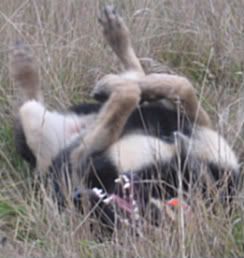Hey Ellen,
I've got to completely agree with Mara and what I think Connie was getting at.
I too think you're reading a lot into this dominant thing when it really is the only way he knows how to protect himself and communicate with you. He's trying to build that bond, figure out his new people and what works in his world.
To me it's pretty simple, especially with rescues. Ignore what you don't like and train a behavior that you do want in its place.
Like if you don't want him going in the bedroom, show him how much better it is just outside the door. Call him out, lure him out with a yummy treat if you have to and reward him for ending up in a place that is acceptable. Fill a treat ball that he can relax with in that spot. Once he consistently understands where his place is, he will start understanding where it is not and the corrections for it. You won't get so much back talk.
He's been placed in the basement with dogs that he doesn't care for. He's probably had a few forced meet and greets with excited, reactive dogs and has now taken on the "No, you don't just want to play, you're aggressive and ill mannered and I'm not having any of it" attitude. Personally, I don't blame him.
He now gets "No'd", leash corrections and his breath taken away for his efforts in trying to keep these dogs out of his face. As you've said, it's escalating so he's also not understanding the corrections. Lose, lose situation.
I too rescued a very segregated dog. Didn't see the outside of his fenced yard BUT, he had also not been exposed to a lot of dogs. This was one area I knew we had a clean slate to start with.
He was introduced to my then, two older, very sedate dogs on neutral ground. The meet and greet was calm and respectful and everyone has gets along famously.
He has no dog aggression issues. Dogs can bark and bounce all around him but he knows that I will never put him in a situation that he has to defend himself against a dog that "is just being friendly". Read that sarcastically because most owners don't have a clue how to read the rude behavior of their over excited, under exercised dogs and are looking for other dogs to do the work for them. It doesn't usually end up pretty, as you're now experiencing.
I know you know this, but there's a lot more to leadership than simply putting a dog in a crate. The crate is a sort of forced confinement while you're training him to contain himself and follow your directions without the walls.
As Mara has questioned, what are the top three things you want to work on right now? When you start to get some consistent success and you've really opened up those lines of communication, you'll know when it's time to start reducing the crate time.
Personally, I'd be working Obedience (Sit, Stand, Down, Heel) up and down your building's hallway. Late at night, really early in the morning. Allow him to learn and really understand those commands in that particular venue.
The secure walls of crate are just as much for changing your approach as they are for teaching him about your control. It's not a magic bullet and doesn't do it automatically though. It's what you do when he's out of the crate that will forge that true respectful relationship.
And again please, protect him from the other dogs so he doesn't have to. He's telling you that those relationships are too confusing right now, he's still trying to figure his leaders out.
You need to show him what a trusting leader is. Keep it simple, keep him safe.
He's sounds like a really fun pup, just some stuff work out and I'm sure the folks here can offer a lot of help. Welcome!!!
 Previous Topic
Previous Topic Index
Index Next Topic
Next Topic













 Top
Top

 He's broadly hinting/asking for (even being pushy about) that scritch. You can ignore it, or you can require something for it. I require something.
He's broadly hinting/asking for (even being pushy about) that scritch. You can ignore it, or you can require something for it. I require something. 
.jpg)


